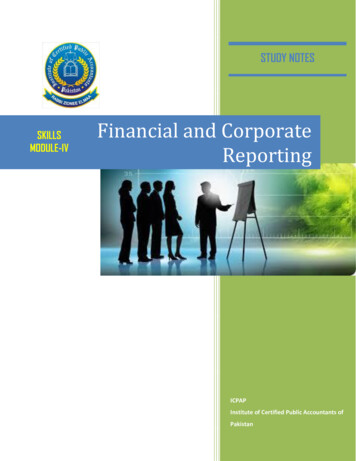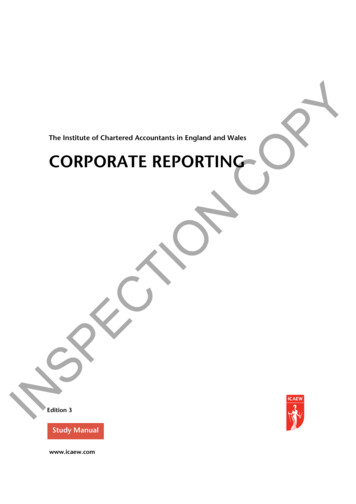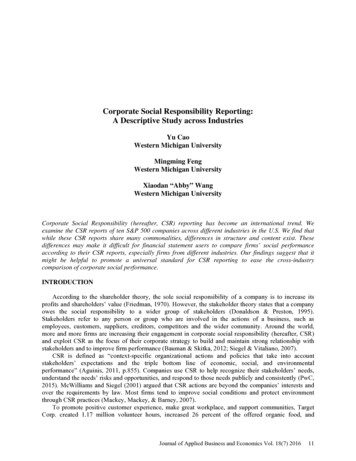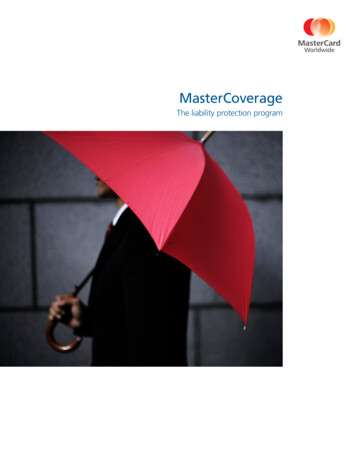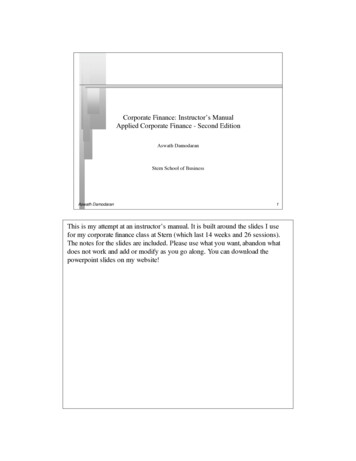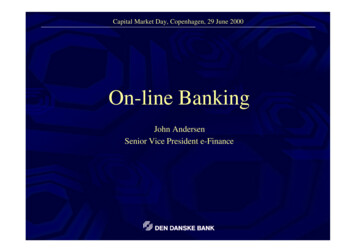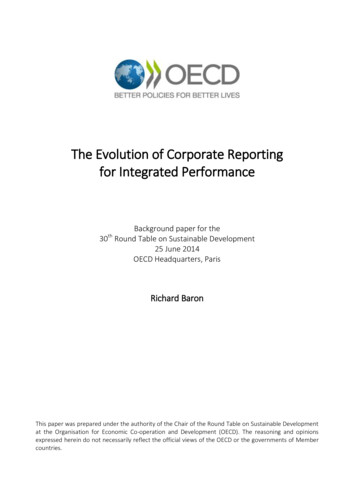
Transcription
The Evolution of Corporate Reportingfor Integrated PerformanceBackground paper for the30 Round Table on Sustainable Development25 June 2014OECD Headquarters, ParisthRichard BaronThis paper was prepared under the authority of the Chair of the Round Table on Sustainable Developmentat the Organisation for Economic Co-operation and Development (OECD). The reasoning and opinionsexpressed herein do not necessarily reflect the official views of the OECD or the governments of Membercountries.
ACKNOWLEDGEMENTSThe OECD Round Table on Sustainable Development would like to thank the World BusinessCouncil for Sustainable Development (WBCSD) for their support on this work. Rodney Irwin and AnneLéonore Boffi in particular provided invaluable guidance and information throughout the elaboration ofthis Round Table and the background paper.The following OECD colleagues contributed ideas and feedback: Simon Upton, Mats Isaksson, AlissaAmico, Marie-France Houde and Tihana Bule. The author is also very grateful to Amelia Smith for herbackground research, suggestions, and editing.For their input and specific comments on an earlier draft of this paper, the author would like to thank:Anne-Léonore Boffi, Kitrhona Cerri and Eva Zabey (WBCSD), George Serafeim (Harvard BusinessSchool). Thanks are also due to Patricia Crifo (Université Paris Ouest Nanterre la Défense, EcolePolytechnique, France and CIRANO, Montréal) for her guidance on the economic theory aspects of thisissue. The author is responsible for errors and omissions.The Round Table on Sustainable Development gratefully acknowledges financial support provided bythe World Business Council on Sustainable Development.2
TABLE OF CONTENTSACKNOWLEDGEMENTS .2EXECUTIVE SUMMARY AND QUESTIONS FOR DISCUSSION .4INTRODUCTION AND DEFINITIONS .61. STATE OF PLAY OF REPORTING OF CORPORATE RESPONSIBILITY .81.1 Corporate reporting in brief .81.2 The emergence of corporate social responsibility .81.3 Drivers and status of ESG disclosure .10The ESG reporting toolkit .11The regulatory side .13Quality of ESG reports today .142. THE IMPACT OF CORPORATE RESPONSIBILITY .162.1 Why companies engage in corporate responsibility: a quick look at economic theory. .162.2 Evidence of actual impact of corporate responsibility on companies.172.3 How do investors look at corporate responsibility? Do ESG disclosures help? .203. REPORTING FOR BETTER & INTEGRATED PERFORMANCE .223.1 ‘One report’: towards integrated reporting .22A framework for integrated reporting.23Going forward with integrated reporting .253.2 Monetising corporations’ externalities .253.3 Mandatory ESG reporting? .26CONCLUSION .27REFERENCES .28ANNEX A – INSTRUMENTS AND STANDARDS FOR CORPORATE RESPONSIBILITY .333
EXECUTIVE SUMMARY AND QUESTIONS FOR DISCUSSIONCorporations are increasingly looked to as agents of change in a world facing mountingenvironmental and social problems, where policy-makers sometimes struggle to garner the supportnecessary for bold policies. As part of their strategy and in response to stakeholder pressure, more andmore businesses now go beyond strict compliance with environmental and other local regulations. Thesebusinesses want to inform stakeholders, from investors to consumers, about their corporate responsibilityefforts. As a result, the corporate disclosure of environmental, social and governance (ESG) aspects hasdeveloped in a variety of directions over more than two decades.In the meantime, the financial crisis cast doubt on corporate reporting as a credible source ofinformation on companies’ health. Yet reporting is an essential link in our economies: the provision offinancial (and now extra-financial) information about corporations is essential for investors to make propercapital allocation choices, and for other stakeholders.At present, investors and other stakeholders can be confused by the information in ESG disclosures:it is difficult to compare ESG performance across companies; the reported information sometimes appearsdisconnected from the company’s business lines or products, making it difficult to assess its importance;and it can omit risks and opportunities that are material to the business and to society, despite dozens oreven hundreds of pages of less relevant data.The importance of ESG disclosures should however not be underestimated: they reflect internalprocesses and changes that can improve a company’s strategy and its durability, as well as its contributionto public goods. Such behaviour is to be encouraged in the face of the short-termism of markets, as someinvestors are increasingly looking for financially robust and resilient companies, and society demands abetter allocation of its capital resources.We have gathered a growing body of evidence according to which companies with a strong ESGrecord deal better with a range of risks and opportunities – these companies should be attracting morecapital than their less ESG-prone counterparts. Corporate responsibility has not hampered companiesfinancially; in fact, durable, strong ESG performance seems to enhance financial performance. Thisevidence, combined with the contribution of these companies to society, makes a strong case for policymakers to: 1) push for more company engagement in ESG; and 2) ensure some coordination and alignmentacross existing frameworks, guidelines and regulations to facilitate progress.The community of corporate ESG reporting is working to respond to its challenges with newframeworks such as integrated reporting (a single report bringing together financial and ESG aspects, witha narrative on the firm’s ability to create value in the future), and various guidelines and practices.Round Table participants are asked to consider the following questions: Are corporate disclosures on non-financial performance being made use of? If so, by whom andwith what effects? If not, why? Does corporate reporting need to evolve in order to shiftinvestment behaviour? What evolutions of corporate reporting are currently being envisaged, with what motives, andwhat chances of success? Do we need a new definition of corporate performance? What wouldbe the consequences for financial capital valuation methods and reporting? What role can governments and regulations play in an area where voluntary initiatives abound?What role can stock exchanges play?4
What information would motivate financial markets to become part of the leadership that willput us on a long-term sustainable trajectory? How can we overcome the “short-termism” ininvestment decision-making often identified as a critical barrier to addressing sustainabilitychallenges? How can investments in sustainability be stimulated?5
INTRODUCTION AND DEFINITIONSInvestors have lost trust in corporate information since the global financial crisis.ACCA (2013b)Nor is [corporate ESG] information provided in any meaningful way that can becompared with figures for their peers.David Blood, Generation Investment Management, in (ACCA, 2013b)1.The disclosure of corporate environmental, social and governance aspects has recently become atopic of much attention. Global and local impacts of corporate activities (human rights, climate, air, soiland water pollution) are under much scrutiny from civil society, and companies are being held accountablefor misdeeds across their full value chains (e.g. the death of 1,138 Rana Plaza workers in 2013). At thesame time, a large and continuously growing number of companies are reporting voluntarily on ESGaspects of their activities.2.ESG disclosures emerged as part of corporate social responsibility (CSR, also known ascorporate sustainability and responsibility) on a voluntary basis, as a means for companies to present theiractions beyond strict compliance. They have also been encouraged by the international community,stakeholders and governments through various guidelines, and again recently at the Rio 20 Summit in2012.1 Some countries and regions are mandating ESG reporting for listed companies or those above acertain size.3.For years, companies developed their own performance indicators and measurement methods;2responsible investors and accounting and auditing firms pushed for the development of guidelines or acommon practice for ESG reporting, and some homogeneity is now emerging. There are nonethelessquestions about the usefulness of the masses of information produced to detail companies’ corporateresponsibility performance. Yet good practice in this area turns out to be critical for the achievement ofstable economic growth (companies that manage risk better last longer) and for more effective solutions tomounting environmental problems, even if the burden cannot fall on companies’ shoulders alone.Transparency and comparability of corporate performance in ESG must become the topic of policymaking: it is not a luxury that only financially wealthy companies indulge in – good practice in this areashould be rewarded and become a distinctive feature for investors. A proper alignment of society’s andinvestors’ aspirations should be the goal: notwithstanding the importance of public policy to addressexternalities, corporate ESG disclosure is an important link – also because it already drives and couldfurther drive corporate change.4.This paper provides the state-of-play on ESG reporting, starting with an overview of corporateresponsibility and what tools have governed its evolution so far. Section 2 summarises the latest findingsabout what corporate responsibility has meant for companies, more from a macro- rather than microperspective. Section 3 describes the latest proposals for an evolution of corporate reporting.1Under paragraph 47 of the Rio 20 conclusions, countries encourage companies to integrate sustainabilityinformation in their reporting cycle and to develop best practice in this area (United Nations, 2012).2Balance scorecard metrics is an example of an innovative measurement instrument helping companies to formbetter strategies by looking beyond financial performance.6
5.Several terms and acronyms are used throughout this paper, and are central to the issue:Corporate Social Responsibility: the integration by companies, on a voluntary basis, of socialand environmental concerns, which reflects perceptibly on their internal operations and relationswith stakeholders. Two important notions govern this definition: 1) voluntary: going beyondcompliance; and 2) perceptible: CSR must result in marked changes in the company’s activities(Kitzmueller and Shimshack, 2012). The European Commission recently defined CSR as “theresponsibility of enterprises for their impacts on society” (EC, 2011). Companies now usevarious terms when reporting on their CSR activities, including: sustainability; corporateresponsibility; sustainable development; corporate citizenship; people, planet, profit; orenvironmental and social report (KPMG, 2013). This variety is a sign of more elaboratestrategies, going beyond purely philanthropic activities.ESG: Environmental, social and governance aspects of companies’ activities, typically coveredby corporate social responsibility.Integrated reporting (IR): the disclosure by a company of information on its near, medium andlong term capacity to generate value, including material risks and opportunities related to all itscapitals: financial, manufactured, intellectual, human, social and relationship, and natural (IIRC,2013).Integrated performance: a company’s performance once it has integrated the extra-financialdimensions of its actions, taken the full measure of its other, non-financial, capitals and reflectedthem in its business model.Integrated thinking: “the active consideration by an organization of the relationships betweenits various operating and functional units and the capitals that the organization uses and affects.Integrated thinking leads to integrated decision-making and actions that consider the creation ofvalue over the short, medium and long term. Integrated thinking can be contrasted withtraditional ‘silo thinking’” (IIRC, 2013).Materiality: There are two distinct definitions of materiality relevant to corporate reporting: 1)the materiality of what a company does (“material aspects are those that reflect the organization’ssignificant economic, environmental and social impacts; or substantively influence theassessments and decisions of stakeholders” [GRI, 2013a]); 2) materiality from the standpoint ofan investor in a company (the International Accounting Standards Committee states that“Information is material if its omission or misstatement could influence the economic decisionsof users taken on the basis of the financial statements” [IASC, 1999]).Both notions matter for our discussion: the first definition addresses how stakeholders other thaninvestors may consider the company. The second addresses risks and opportunities from afinancial performance perspective. Materiality is also a critical concept for companies becausethe identification of material aspects requires a close, inward look at the company’s activities andstakeholders, and generates information that supports the identification of risks, better decisionmaking and therefore long-term value creation.7
1. CORPORATE RESPONSIBILITY REPORTING: THE STATE OF PLAY1.1Corporate reporting in briefA strong disclosure regime can help to attract capital and maintain confidence in thecapital markets. By contrast, weak disclosure and non-transparent practices cancontribute to unethical behaviour and to a loss of market integrity at great cost, not justto the company and its shareholders but also to the economy as a whole.OECD Principles of Corporate Governance (2004)6.Reporting has long been an inherent part of the life of companies. The OECD Principles ofCorporate Governance, a recognised international benchmark, state that disclosure should include, but notbe limited to, material information on a company’s: financial and operating results; objectives; foreseeable risk factors.7.The Principles stress that reporting should be realised in accordance with high quality standardsof accounting and financial and non-financial disclosure, and that an independent audit should beconducted to assure that all material aspects are properly represented.38.Widely accepted instruments such as the International Financial Reporting Standards or the USnational Generally Accepted Accounting Principles (GAAP) provide a reference for the disclosure ofinformation by listed companies. The common understanding of these standards and regulations set bysecurities commissions is to help primarily capital providers, but also public authorities and potentialinvestors, understand the financial performance of companies. Not all companies are subject to the samereporting rules, however: publicly listed companies tend to be subject to the highest scrutiny (e.g.publication of quarterly earnings reports and annual reports including financial statements), whileprivately-owned companies have more freedom in choosing what information they disclose to the generalpublic.9.Accounting and disclosure of non-financial elements does not, at present, benefit from auniversally-recognised standard. Reporting of these elements has nonetheless grown tremendously over thepast two decades, as companies acknowledge their responsibility for matters beyond those of a strictlyfinancial nature and, for some, progressively see the value of a more holistic approach to performance.1.2The emergence of corporate social responsibility10.The concept of corporate responsibility is often traced back to Howard Bowen’s book, “SocialResponsibilities of the Businessman”, although references to similar notions date back several decades.4 At3OECD, 2004. The principles are not binding, but meant to provide a reference point. They are currently underreview.4Okoye (2009) finds signs of corporate social responsibility in the late 1920s. Katsoulakos et al. (2004) provide anearlier quote from a 1916 article by J.M. Clark in the Journal of Political Economy: “if men are responsible for theknown results of their actions, business responsibilities must include the known results of business dealings,whether these have been recognised by law or not”.8
the same time, the breadth of the CSR concept (social, human rights, local and global environment) makespinpointing a start date illusory. It has been an incremental process, which became more visible as specificcases were brought to the public eye (e.g. catastrophic oil spills5 or labour abuse leading to demands formore transparency and disclosure regarding companies’ conduct) and through intergovernmental processessuch as the 1972 UN Conference on the Human Environment in Stockholm, the Brundtland Commission(UN, 1987), the 1992 Earth Summit in Rio de Janeiro and ensuing conventions.6 Intergovernmental effortsoutside the environment field also initiated changes in corporate responsibility: in 1974, the UN created acommission to study the impact of transnational corporations, with a view to creating a code of conduct. 7At the OECD, Guidelines for Multinational Enterprises were first adopted in 1976.11.There are many justifications and theories for the emergence of companies’ responsibility beyondthe financial responsibility to their shareholders. They include: new awareness (on the part of stakeholdersand management); growing and visible environmental pressures; policy gaps in the protection of publicgoods; and material risks, including reputational. These convey a rather defensive view of why companiesengage in CSR. While this may have been the early justification for such actions, CSR has alsoundoubtedly led some companies to find new opportunities to create value and ensure their durability,including through the prevention of new risks. Some companies are “taking the offensive”, setting targetspublicly in recognition of serious global problems such as climate change, and as a means to differentiatethemselves from less responsive companies (Kramer and Kania, 2006). Other companies were establishedby visionary entrepreneurs with good corporate responsibility as their foundation.12.Today, stakeholders (employees, local communities, non-government organisations, customersand investors) increasingly turn to a company’s management and shareholders, asking if its businesspractices take full account of the environmental and social dimensions of its activities, and if itsgovernance structures (ESG) meet the expectations of society.13.A growing number of corporations are now engaged in a broad set of ESG activities. Thefollowing is an incomplete list of matters that companies commonly address as part of responsibilitiesgoing beyond compliance with national and international legislation:8 Resource efficiency (energy, water and land use and management, other materials);Release of regulated and unregulated pollutants (e.g. greenhouse gases);Production of hazardous waste;Impacts on biodiversity and ecosystem services;Sourcing of materials (e.g. the use of conflict minerals, trafficking), certification;Use of green products in production and environmental performance of products;Corruption;Human rights;Health and safety;Employment, labour conditions, training, gender balance, turnover rate (talent managementand retention);5Ceres, initially a small group of investors, was founded largely in response to the Exxon Valdez oil spill in 1989.6At the 1992 Earth Summit in Rio, a group of 48 companies created the Business Council for SustainableDevelopment, which later became the World Business Council for Sustainable Development.7The commission was dissolved in 1994 without having agreed to a code of conduct, but its work paved the wayfor the UN Global Compact adopted in 1999.8This list is partly based on Hesse (2012) and on GRI (2013).9
Communication with stakeholders (investors, suppliers, customers, employees, nongovernmental organisations, authorities, communities);Corporate governance (e.g. composition of the board of directors, communication withstakeholders, executive compensation).14.The management of these and other ESG aspects requires that companies identify performanceindicators, set appropriate measurement methods, develop data management systems and controls, andestablish internal decision-making processes to address potential risks and opportunities. Disclosure of thisinformation should be considered one, but certainly not a unique, outcome of companies’ ESG activities.More importantly, these activities can improve decision-making, helping to offset risk (brand, reputation,and regulatory), enhance efficiency, and increase revenues and market shares via innovation or a strongerbrand reputation, to name a few.1.3Drivers and status of ESG disclosureCorporate responsibility reporting is – or should be – an essential businessmanagement tool. It is not – or should not be – something produced simply to mollifypotential critics and polish the corporate halo.Yvo de Boer (KPMG, 2013)15.Corporate reporting on ESG aspects is now a widespread activity, at least among largecompanies. KPMG (2013) indicates that 71 percent of the top 100 companies in 41 countries now report onESG, against 64 percent in 2011, with some countries (e.g. India) displaying spectacular growth over theperiod (20 percent to 73 percent). Such progress is sometimes the result of new regulation.9Figure 1. Corporate responsibility reporting by region(percentage of companies with CR reports)Note: Based on a KPMG survey of the 100 largest companiesin 41 countries (KPMG, 2013)9India’s Security Exchange Board mandates top 100 listed companies to adopt the country’s National VoluntaryGuidelines for Social, Environmental and Economic Responsibilities of Business (KPMG 2013).10
16.There are various reasons for today’s diversity in corporate ESG disclosure: the voluntary natureof corporate responsibility activities for some companies; the evolving range of stakeholders; and thegrowing number of issues that companies are asked to tackle (e.g. recently, on climate changevulnerability).The ESG reporting toolkit17.This section focuses on the current, well-established tools in the ESG reporting kit. Newevolutions (integrated reporting in particular) are covered in more detail in Section 3.18.We propose the following typology of instruments mobilised in ESG reporting, going from thegeneral to the more specific: principles; guidelines; standards; methods.Annex A provides a more complete list of corporate responsibility instruments, including sectorand issue-specific.19.The following are examples of principles for corporate reporting, established by major, visibleorganisations. Some relate to a subset of ESG aspects, e.g. human rights; others seek to be broadlyencompassing. The OECD Guidelines for Multinational Enterprises (MNE Guidelines), a set ofrecommendations adopted by governments, addressed to multinational companies thatoperate in or from adhering countries. The Guidelines encourage a second set of disclosurecovering social, environmental and risk dimensions, in addition to financial, performance,ownership and governance, (OECD, 2011). The MNE Guidelines do not mandate anyspecific reporting format, but introduce a formal system of National Contact Points thatstakeholders can approach if a company does not respect the principles of the Guidelines. Asof 2014, all 34 OECD countries and eight non-member countries10 adhere to the Guidelines. The UN Global Compact, which companies and NGOs can adhere to, has ten principles inthe areas of human rights, labour, the environment and anti-corruption (UNGC, 1999). As of2014, it reported some 8,000 corporate participants. Corporations must report regularly tothe UNGC, via a ‘communication of progress’. The Global Compact does not mandate anyreporting framework, but its website states: “GRI [the Global Reporting Initiative] is apractical expression of the Global Compact.”11 The UN Guiding Principles on Business and Human Rights, endorsed by the UN HumanRights Council in 2011. These principles include several references to reporting, but do notmandate any particular format. The OECD MNE guidelines were amended in 2010 toinclude a chapter on human rights consistent with the UN Guiding Principles (OECD, 2011).10Argentina, Brazil, Egypt, Latvia, Lithuania, Morocco, Peru and Romania.11The two organisations created a strategic alliance in 2006, the UNGC-GRI Value Platform.11
ISO 26000: Social Responsibility. In spite of being published by the InternationalOrganization of Standardization, and labelled an “ISO International Standard”, ISO 26000only represents a global consensus on the state of the art of the topic, and cannot be subjectfor certification – i.e. it is not, strictly speaking, a standard. It covers a broad range of CSRdimensions12, but does not offer specific guidance on reporting (GRI, 2010). The International Finance Corporation Performance Standards on Environmental and SocialSustainability, which establish codes of conduct for IFC clients (IFC, 2012), in eight areas(including the assessment and management of environmental and social risks and impacts,biodiversity, or cultural heritage). The IFC does not prescribe any specific reportingframework for these activities. More recently, in the conclusions of the Rio 20 summit, countries “acknowledge theimportance of corporate sustainability reporting and encourage companies, whereappropriate, especially publicly listed and large companies, to consider integratingsustainability information into their reporting cycle.” (United Nations, 2012).20.As for actual guidelines for ESG reporting – i.e. practical advice on how to structure a report oncorporate responsibility – the Global Reporting Initiative (GRI) is emerging as a leader. GRI was created in1997 by Ceres13 and the United Nations Environment Programme to provide guidance on sustainabilityreporting – i.e. specific elements that a corporate sustainability report could include. GRI recently issuedG4 Sustainability Reporting Guidelines.14 GRI recommends third-party assurance of a company’s report,but does not require it (GRI, 2013a).1521.The Carbon Disclosure Project questionnaire is another example of reporting guidelines, in thiscase focusing on climate, water, and forests (CDP, 2013). CDP offers its questionnaire for large companiesto report on the management of the climate change issue, including: the company’s emissions for variousscopes, emissions reduction objectives and management of climate-related risk. Companies decide whetheror not their information will be made public once collected by CDP.22.There are few, if any, standards in the field of ESG reporting, i.e. reporting methods that includethe certification of the final report, conducted by a specially-accredited organisation: The European Union Eco-Management and Audit Scheme (EMAS) can be used bycompanies that have measured their environmental impacts, committed to reduce them, anddeveloped an environmental management system (EMS) to that effect. Participatingcompanies must have all elements of the EMS, including its environmental statement,audited by an accredited environmental verifier (EC, 2014). ISO standard 14064-1 provides “guidance at the organization level for the quantification andreporting of greenhouse gas emissions and removals” (ISO, 2014).12Governance, human rights, labour practices, the environment, fair operating practices, consumer issues,community involvement and development (ISO, 2014).13“Ceres is an advocate for sustainability leadership. Ceres mobilizes a powerful network of investors, companiesand public interest groups to accelerate and expand the adoption of sustainable business practices and solutions tobuild a healthy global economy”. www.ceres.org, viewed on 1 April 2014.14Companies using the GRI guidelines for sustainability reporting can decide to do so ‘in accordance with’ theguidelines, or, more simply, to use some of the Standard Disclosures from the guidelines.15As such, it is therefore not a standard.
about what corporate responsibility has meant for companies, more from a macro- rather than micro-perspective. Section 3 describes the latest proposals for an evolution of corporate reporting. 1 Under . (KPMG, 2013). This variety is a sign of more elaborate stra

